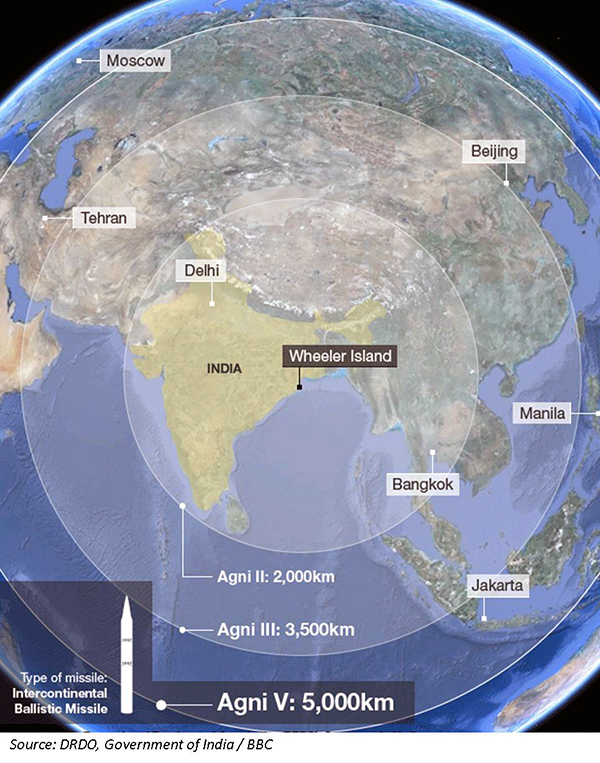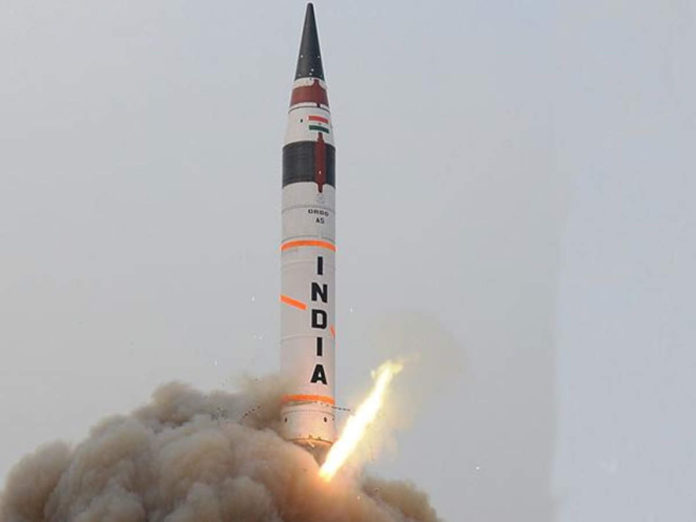ICBM ready for use with Strategic Forces Command
As part of user trial, Agni-5 was successfully launched, on 27 October 2021, from Abdul Kalam Island, Odisha. According to Ministry of Defence (MoD), the test was in line with India’s credible minimum deterrence policy with the commitment to ‘No First Use.’
Seven Pre-trial Launches
On 19 April 2012, Agni V was successfully test-fired for the first time. On 10 December 2018, a seventh test launch of Agni-V was successfully conducted. It was for the first time that the missile was test-fired in a lofted trajectory. The missile blasted off from a hermetically sealed canister and covered nearly 2,041 km. This lofted trajectory flight was used to determine whether it followed the perfect flight path with close to zero error. This trial completed the Agni-V pre-induction trials.
Development
Agni V is primarily for enhancing India’s nuclear deterrence against China. Until recently, the longest range missile India had was Agni-III, with a range of 3000–3500 km. This range was not sufficient to reach targets on the extreme eastern and north-eastern region of China. Most of the important economic centres of China lay on its eastern seaboard. Even with a range of only 5,000 km, the Agni-V could hit any target in China, including Beijing.
Indian authorities believed that the solid-fuelled Agni-V is more than adequate to meet current threat perceptions and security concerns.
The missile will allow India to strike targets across Asia and into Europe. The missile’s range will allow the Indian military to target all of China from Agni-V bases, in central and southern India, further away from China.
The missile was designed to be easy to transport by road, through the utilisation of a canister-launch missile system, which is distinct from those of the earlier Agni missiles. Agni-V would also carry MIRV (multiple independently targetable re-entry vehicles) payloads being concurrently developed. A single MIRV equipped missile can deliver multiple warheads at different targets.


Agni-V incorporates advanced technologies involving ring laser gyroscope and accelerometer for navigation and guidance. With a canister-launch system to impart higher road mobility, the missile, will give the armed forces much greater operational flexibility than the earlier-generation of Agni missiles. The accuracy levels of Agni-V and the Agni-IV, with their better guidance and navigation systems, are far higher than previous Agni series.
About Agni-5
Propulsion. The Agni-V is a three-stage solid fuelled missile with composite motor casing in the second and third stage. In many aspects, the Agni-5 carries forward the Agni-3 pedigree. With composites used extensively to reduce weight, and a third stage added on (the Agni-3 was a two-stage missile), the Agni-5 can fly significantly more to inter-continental range.
Range. Former DRDO chief VK Saraswat once disclosed the range of Agni-V as 5,500–5,800 km. The Chinese believe that the missile has a range of around 8,000 kilometres. The exact range of the Agni-V missile is classified.
Guidance and control. A ring laser gyroscope based inertial navigation system (RLG-INS) is primarily responsible for guiding the Agni-V to its target. However, Agni-V is equipped with another guidance system called micro inertial navigation system (MINGS) as a backup. These are capable of interacting with Indian and non-Indian satellite navigation systems. Both of these systems have been developed by the Research Centre Imarat. Agni V uses a system on chip (SOC) based on-board computer (OBC) whose weight is around 200 grams for control and guidance. All stages of the missile have nozzle-based control systems.
Mobility. The Agni-5 is specially tailored for road-mobility. With the canister having been successfully developed, all India’s future land-based strategic missiles will be canisterised as well. Made of maraging steel, a canister must provide a hermetically sealed atmosphere that preserves the missile for years. During firing, the canister must absorb enormous stresses when a thrust of 300 to 400 tonnes is generated to eject the 50 tonnes missile. If the missile is ejected using a gas generator from the canister, then the missile could be launched from any pre-surveyed launch location without the need for any pre-built launch site.
The launcher, which is known as the Transport-cum-Tilting vehicle-5, is a 140-ton, 30-metre, 7-axle trailer pulled by a 3-axle Volvo truck.
Anti-satellite version. Dr VK Saraswat said that an ASAT version is technically possible: ASAT weapon would require reaching about 800 km altitude. Agni V offers the boosting capability and the ‘kill vehicle’, with advanced seekers, will be able to home into the target satellite.
MIRVs. Agni-V is expected to feature Multiple independently targetable reentry vehicle (MIRVs) with each missile being capable of carrying 2–10 separate nuclear warheads. Each warhead can be assigned to a different target, separated by hundreds of kilometres; alternatively, two or more warheads can be assigned to one target. MIRVs ensure a credible second strike capability even with few missiles. According to DRDO sources, a MIRV payload would be significantly heavier, since it would consist of several nuclear warheads, each of them weighting about 400 kilogrammes. A 5-warhead MIRV, therefore, would weigh two tonnes.
The MIRV capability of Agni-V has been tested indirectly in a discreet manner, according to Bharat Karnad, who was involved in drafting India’s nuclear doctrine. Karnad states that the MIRV capability of the missile’s guidance system on chip (SOC) was tested during the multi-satellite PSLV launch on 25 February 2013.
Global Reactions
When India tested the Agni-V missile for the first time in 2012, then China’s foreign ministry spokesperson, Liu Weimin stated, “China and India are both emerging powers. We are not rivals, but cooperative partners.” He further stated, “China always maintains that preserving the strategic balance and stability in South Asia is conducive to peace and prosperity of regional countries and beyond.” But state run daily, Global Times reported, “India was being swept up by missile delusion” and that China’s neighbours could never win an arms race with China.” In 2017, China’s state run Global Times accused India of violating UN restrictions on range of missiles over the Agni-IV test and instead claimed that Pakistan should also be allowed the same privileges.
The United States views India as a strong partner in the Indo-Pacific Region to counter China’s growing influence also refrained from criticising India’s 2012 Agni-V test and instead applauded India’s non-proliferation efforts then. This came as a stark difference between how the US viewed India’s missile capabilities from the early 2000s and now.
Pakistan on the other hand reacted to Pakistan centric Agni tests with tit-for-tat tests. For instance, when in 1999, India tested its Agni-II missile, Pakistan followed suit by testing the Ghauri missile followed by the Shaheen-I missile. In 2003, Pakistan’s Information Minister, Shaikh Rashid warned India that such tests conducted by India would not help New Delhi to “establish its supremacy in the region.” Prior to this, in 2001, Pakistan reacted to Agni-II missile criticising India, “India’s nuclear ambitions, which are clear from its draft nuclear doctrine announced in 1999, have a destabilising effect on the region.” In fact, just after India’s testing of China-centric Agni missiles, Pakistan in March 2018, acquired a powerful missile tracking system from China that is expected to speed up Pakistan’s ability to develop MIRV technology.
Nuclear Deterrence
It is crucial for India to develop the Agni missile system as a deterrence against China through second-strike capability. China though has adopted a policy of “no-first-use”, such a policy does not apply to territories that China considers to be a part of its own territory. This has been with Taiwan and India’s Arunachal Pradesh as China considers them to be a part of its own territory.
Agni constitutes the backbone of India’s land-based nuclear deterrence just like the Shaheen category ballistic missiles for Pakistan and the Dong Feng category missiles for China.
The Agni category missiles are solid propelled ballistic missiles, ranging from short range missiles to intermediate range missiles (700-5000kms) with road and rail mobility providing greater chances of survivability during an enemy attack. This strengthens its scope of launching a counter/second strike. This makes India one of the few countries in the world with the ability to potentially decapitate its enemy by preserving its arsenal in the first attack from the enemy.
Solid propulsion systems, use of increased stages to increase ranges, advanced guidance and navigation system equipped with the missile, easy mobility – all these characteristics in a missile make the system more credible and reliable thereby strengthening India’s strategy of “credible minimum deterrence.” Mobility makes the missiles more easily survivable to enemy attack thereby strengthening their ability to launch “counter/second strike” vis-à-vis adversaries.
With two neighbours with nuclear capability, India needed to have nuclear weapons delivery systems that could not only carry nuclear warheads but also be able to successfully deliver the same despite enemy defence by denial mechanisms. For instance, canister launched missiles are more agile and capable of dodging enemy radars and also spy satellites.
Though it is not clear if Agnis would be based in silos also, there is a possibility that a small number of missiles are silo-based with dummy silos too to evade missile attacks. It is also possible that over the years, India has also hardened the silos to avoid the enemy from attacking and destroying the missiles kept in the silos.













